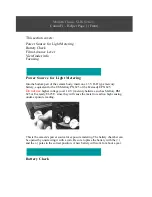
Alignments
6.
6.
Alignments
Index of this chapter:
6.1 General Alignment Conditions
6.2 Hardware Alignments
6.3 Software Alignments
6.4 Option Settings
6.5 Reset of Repaired SSB
6.6 Total Overview SAM modes
6.1
General Alignment Conditions
Perform all electrical adjustments under the following
conditions:
•
Power supply voltage: 90 - 264 V
AC
, 50/ 60 ± 3 Hz.
•
Connect the set to the mains via an isolation transformer
with low internal resistance.
•
Allow the set to warm up for approximately 15 minutes.
•
Measure voltages and waveforms in relation to correct
ground (e.g. measure audio signals in relation to
AUDIO_GND).
Caution:
It is not allowed to use heat sinks as ground.
•
Test probe: Ri > 10 M
Ω
, Ci < 20 pF.
•
Use an isolated trimmer/screwdriver to perform
alignments.
6.1.1
Alignment Sequence
•
First, set the correct options:
–
In SAM, select “Option numbers”.
–
Fill in the option settings for “Group 1” and “Group 2”
according to the set sticker (see also paragraph
).
–
Press OK on the remote control before the cursor is
moved to the left.
–
In submenu “Option numbers” select “Store” and press
OK on the RC.
•
OR:
–
In main menu, select “Store” again and press OK on
the RC.
–
Switch the set to Stand-by.
•
Warming up (>15 minutes).
6.2
Hardware Alignments
Not applicable.
6.3
Software Alignments
Put the set in SAM mode (see Chapter
). The SAM menu will now appear on
the screen. Select ALIGNMENTS and go to one of the sub
menus. The alignments are explained below.
The following items can be aligned:
•
White point
•
Ambilight
•
TCON Alignment
•
Reset TCON Alignment.
To store the data:
•
Press OK on the RC
before the cursor is moved to the
left
•
In main menu select “Store” and press OK on the RC
•
Switch the set to stand-by mode.
For the next alignments, supply the following test signals via a
video generator to the RF input:
•
EU/AP-PAL models:
a PAL B/G TV-signal with a signal
strength of at least 1 mV and a frequency of 475.25 MHz
•
US/AP-NTSC models:
an NTSC M/N TV-signal with a
signal strength of at least 1 mV and a frequency of 61.25
MHz (channel 3).
•
LATAM models:
an NTSC M TV-signal with a signal
strength of at least 1 mV and a frequency of 61.25 MHz
(channel 3).
6.3.1
PC mode display adjustment
General set-up
Alignment set-up diagram
The alignment has to be done in a subdued lighted room. The
ambient Light may be maximum 5 NIT.
Equipment requirement
Minolta Colour Analyser CA-210 / CS-200 and Quantum Data
802BT Video Test Generator.
Input signal types
Apply full white pattern to the HDMI input, apply 1080p 60 Hz.
Alignment set-up:
1.
Input pattern for White Point alignment.
2.
Press “0 0 0 1 8 3 MUTE” to enter the iTV mode.
3.
The alignment has to be made for “Cool”, “Normal” and
“Warm” settings.
4.
Use a contactless analyzer for the LCD display.
Alignment method
1.
Place the colour sensor of the meter at the centre of the
screen with standard orientation (at 0 degree orientation).
2.
Set the meter in (T, Duv) or (x, y).
3.
Set the picture format to Unscaled, set the light sensor to
off, set the brightness to 50, set the colour to 50 and set the
contrast to 100.
4.
Set colour temperature to “COOL”.
5.
White point red, White point green, White point blue
register must be set to maximum value of 128.
6.
Press “0 6 2 5 9 6 INFO” to enter BE factory mode.
7.
At SAM mode menu, adjust the SCALER_GAIN_R,
SCALER_GAIN_G, SCALER_GAIN_B values to meet
“COOL” colour coordinates specification below. Then store
those values to NVM.
Alignment requirement at the centre of the screen
Pre-check panel whether the uniformity is correct and check
the initial surface luminance, white tone colour R/G/B gain =
128.
•
22" panel : > 300 cd/m
2
.
•
26" panel : > 400 cd/m
2
.
•
32" panel : > 450 cd/m
2
.
Adjusting “Scaler Gain” in factory mode. These R/G/B gain
value < 128 to avoid saturation at the 11-step grey pattern.
This group setting of colour temperature will be applied
automatically to the TV / VGA / HDMI / AV sources.
Table 6-1 The 1931 CIE chromaticity (x, y) by CS-200
If you do not have a colour analyser
, you can use the default
values. This is the next best solution. The default values are
average values coming from production.
Picture Mode
x
y
Normal (9000K)
0.287
±
0.003
0.296
±
0.003
Cool (11000K)
0.276
±
0.003
0.282
±
0.003
Warm (6500K)
0.313
±
0.003
0.329
±
0.003
















































